Enhancing Rural Resilience through Appropriate Development Actions (ERADA)
Nearly 250 million people in India live in and around forests. The state of Jharkhand in eastern India is home to above 7 million people from indigenous and tribal communities such as the Birhor, Korwa, Santhal, Munda (in Hindi language) among others. Many of these families depend on forests and forest produce for their living. The value of Non-Timber Forest Produce (NTFP) in Jharkhand is estimated to be above 100 million euros per year (Jharkhand Forest Department 2019). In Dumka district of Jharkhand, NTFP like Tamarind (Tamarindus indica) and Mahua (Madhuca longifolia) play a crucial role in the food, livelihood, nutrition and culture of the indigenous communities, making it essential to empower them to use these resources sustainably. However, declining awareness about the nutritional benefits, lack of facilities for proper harvest, processing and value addition, and limited market access have been challenges for the forest dwelling communities to generate substantial incomes from NTFP.

The Indo-German development cooperation project ERADA ‘Enhancing Rural Resilience through Appropriate Development Actions’ strengthens the livelihoods of vulnerable households including indigenous groups, women headed households, migrant communities and others through locally available natural resources and developmental support programmes. ERADA works in eight severely distressed areas ranking high in multidimensional poverty indices across four Indian states namely, Bihar, Jharkhand, Madhya Pradesh and Rajasthan. The project implements a living income enhancement approach for vulnerable households. The globally acclaimed ‘Anker methodology’ (also supported by the BMZ through the Living Income Community of Practice) was adapted to conduct the living income assessment in each of the eight project locations. Based on the assessment, locally suitable livelihood interventions were determined for each of the locations. Overall, the project works through a three-dimensional approach:
- Strengthening the participation of vulnerable households in the public employment programme of Government of India- Mahatma Gandhi National Rural Employment Guarantee Act (MGNREGA) through more inclusive planning processes, use of digital tools, gender responsive measures etc.
- Diversifying the livelihoods of vulnerable households through skilling and entrepreneurship development, improved access to finance and markets, technical support for value addition and marketing.
- Developing convergence mechanisms for improved collaboration of government programmes for pooling resources for planning and implementing village development plans for the benefit of vulnerable households.
The basket of livelihood activities for each location is identified based on local practices, agro-climatic conditions, resource availability, the demands from the community and the strength of Government programmes. In the project location of Masalia block in Dumka district in Jharkhand state of India, NTFP based activities were identified for intervention. After deliberations with the community and government officials, Tamarind and Mahua were selected as the focus products. The versatile Mahua tree, revered in Jharkhand’s indigenous culture, offers diverse produce including the mahua flowers that are primarily used for making alcoholic beverages. Mahua offers nutritional and medicinal properties which are unexplored to a great extent. Further, these flowers are not plucked but handpicked from the forest floor that are at times bushy, dense, and inaccessible. For convenience in collection, the forest floors are often set on fire limiting the collection and destroying the biodiversity. Similarly, tamarind is a widely cultivated tree in India with significant scope for value addition. Limited awareness, grading and storage facilities affected the quality of produce and thus, marketability.
The ERADA project works with 228 mahua farmers and 54 tamarind farmers in Masalia. All of them are women farmers from indigenous tribal communities, and part of the women Self-Help Groups under the National Rural Livelihood Mission (NRLM) of the Government of India. Firstly, an intensive diagnostic exercise was conducted to analyse the current conditions, local practices, quality of infrastructure, government programmes etc. Accordingly, the training sessions were organised alongside the harvest seasons of mahua and tamarind, to enable hands-on training and application of the learnings immediately.
Better collection of mahua flower was demonstrated by tying a net and pegging it under the tree to avoid the flowers from falling on the ground. Collected mahua flowers in the nets are harvested easily minimizing losses and preserving the forest floor. This enabled a larger quality harvest enabling farmers earn 0.39 euros per kilo compared to 0.17 euros per kilo last year. Natural drying methods, quality check and value addition of mahua flowers into making snacks and food products were also part of the training sessions. This enabled the farmers explore an additional income of up to 1.65 euros per kilo of snacks such as mahua laddoos from the sale in local markets.
In the case of tamarind, value addition, primary processing, grading and sorting were the key focus areas in the training and demonstrations. Tamarind candy and tamarind date sauce were two innovative products that sold well in the local markets. All trainings were done in convergence with the NRLM, the district forest department and the local government administration.
Overall, the focus of ERADA project in Masalia was to improve the quality of NTFP products and increase the income generation of vulnerable forest dweller households. Through enhanced knowledge and technical inputs on sustainable harvesting, processing, value addition and marketing strategies, the women farmers are more confident to continue with and promote NTFP based livelihoods. This is improving their livelihood security, especially in the times of degrading and overexploited natural resources. There is a long way to go to ensure sustained impacts, but the story so far is promising. The way ahead will focus on strengthening convergence with the government programmes, civil society and other institutions to ensure access to finance and markets, and empowering community owned entrepreneurship development.




Link to the further materials
Contact Person
Ms. Meekha Hannah Paul
Key Buzzwords
Rural development, Rural Livelihoods, Forest based livelihoods, MGNREGA, Public Employment Programme, Indigenous communities, Jharkhand, NTFP

